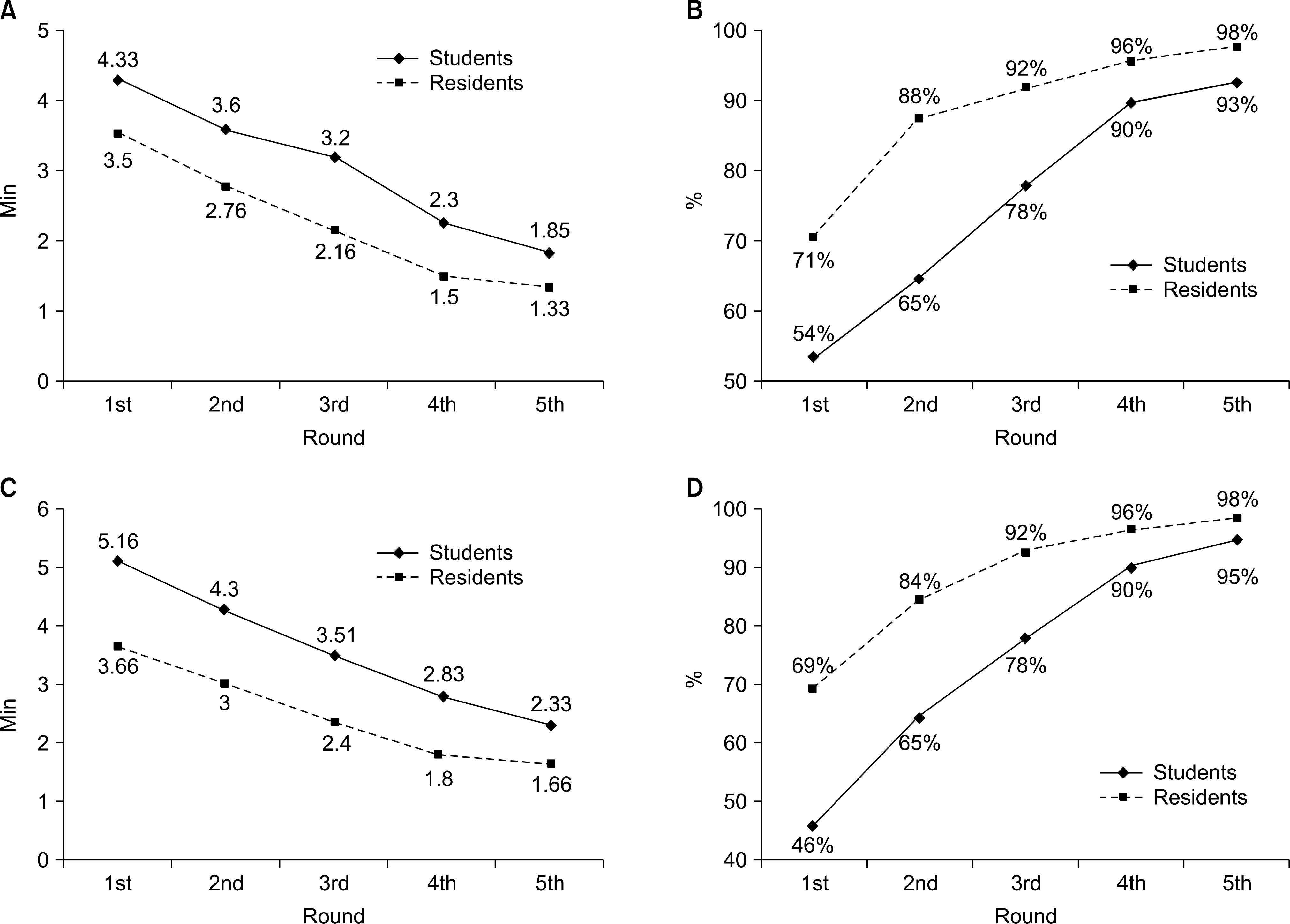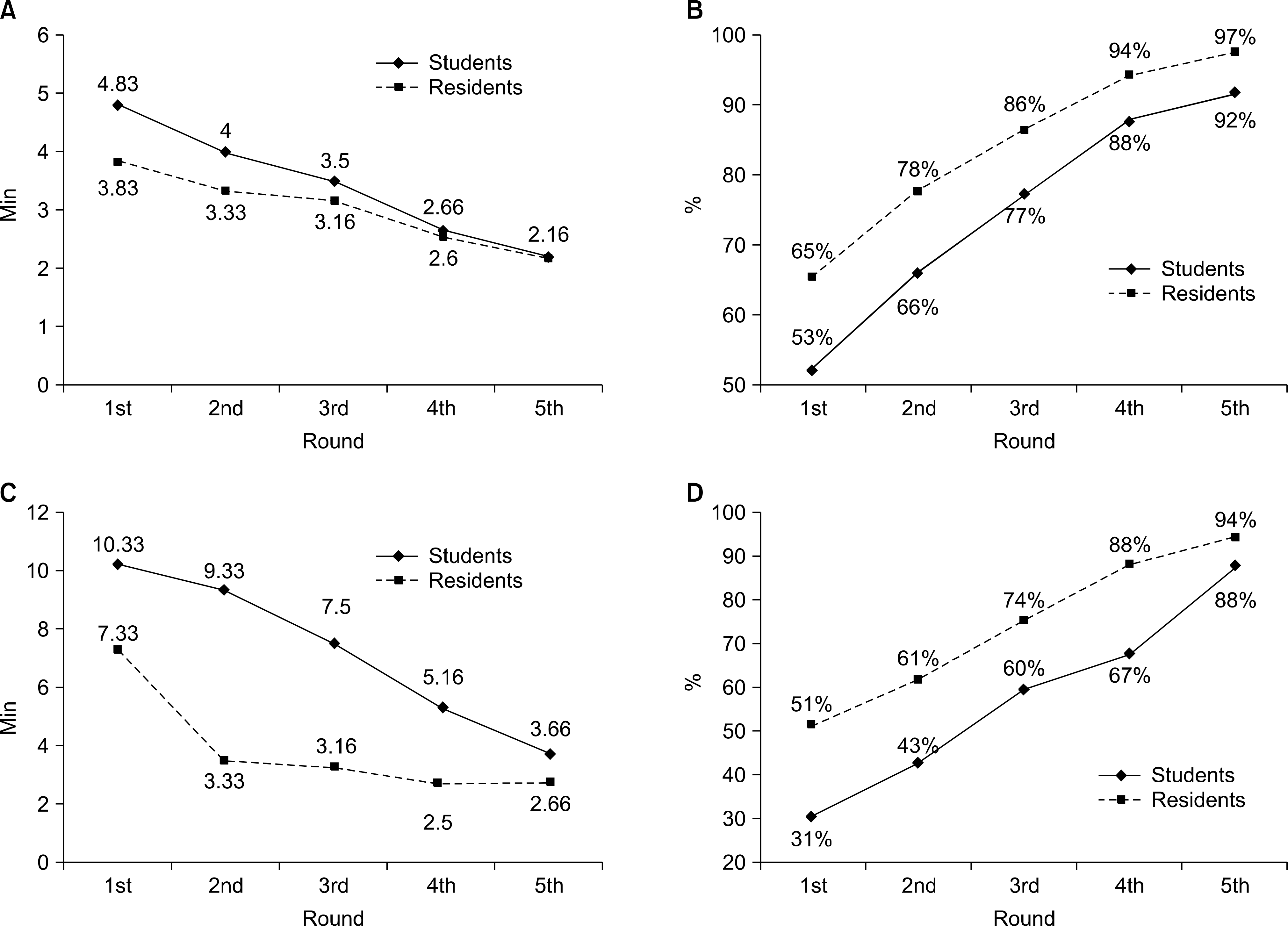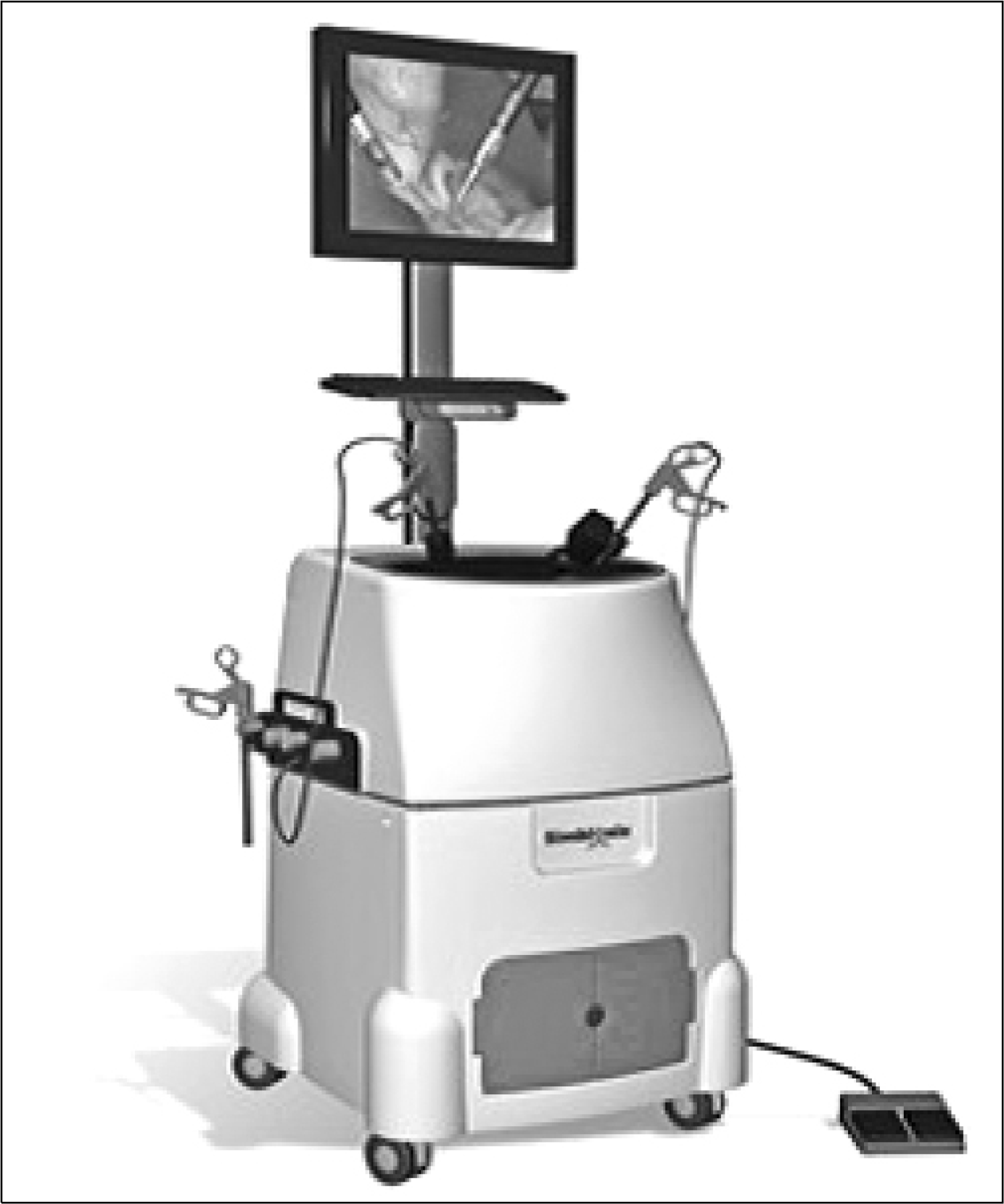Abstract
Purpose
The need for efficient and optimal training through a structured laparoscopic training program has become increasingly evident. Virtual reality simulation may provide a safe and efficient means of acquiring laparoscopic skills. The LAP MentorTM is a high-fidelity virtual reality simulator with haptic feedback that allows a trainee to practice 9 basic laparoscopic tasks including laparoscopic suturing. The purpose of this study was to evaluate the predictive validity of performance on the LAP Mentor before surgical simulators are incorporated into training programs.
Materials and Methods
Eleven participants (6 medical students and 5 residents) underwent laparoscopic skills training on the virtual reality simulator LAP Mentor. Each participant was tested on 5 sets of 4 LAP Mentor basic laparoscopic tasks (grasping, cutting, clipping, and suturing) in a 3-week period. Total time and accuracy were measured for each task.
Results
There was a significant difference between the initial session and the final session for total time and accuracy in both groups. Among the medical students, as they progressed through the training step by step, total time decreased for the grasping task, the cutting task, the clipping task, and the suturing task. At the same time, accuracy improved for the grasping task, the cutting task, the clipping task, and the suturing task, respectively. The residents group showed a similar progression.
Go to : 
REFERENCES
1.Clayman RV., Kavoussi LR., Soper NJ., Dierks SM., Meretyk S., Darcy MD, et al. Laparoscopic nephrectomy: initial case report. J Urol. 1991. 146:278–82.

2.Guillonneau B., Abbou CC., Doublet JD., Gaston R., Janetschek G., Mandressi A, et al. Proposal for a “European Scoring System for Laparoscopic Operations in urology”. Eur Urol. 2001. 40:2–6.
3.Guillonneau B., Rozet E., Cathelineau X., Lay F., Barret E., Doublet JD, et al. Perioperative complications of laparoscopic radical prostatectomy: the Montsouris 3-year experience. J Urol. 2002. 167:51–6.

4.Kim HH. Laparoscopic surgery in urology (I). Korean J Urol. 2003. 44:945–58.
5.Hoznek A., Katz R., Gettman M., Salomon L., Antiphon P., de la Taille A, et al. Laparoscopic and robotic surgical training in urology. Curr Urol Rep. 2003. 4:130–7.

6.Gill IS., Zippe CD. Laparoscopic radical prostatectomy: technique. Urol Clin North Am. 2001. 28:423–36.

7.Shalhav AL., Dabagia MD., Wagner TT., Koch MO., Lingeman JE. Training postgraduate urologists in laparoscopic surgery: the current challenge. J Urol. 2002. 167:2135–7.

8.Dent TL. Training, credentialling, and granting of clinical privileges for laparoscopic general surgery. Am J Surg. 1991. 161:399–403.

9.Medina M. Formidable challenges to teaching advanced la-paroscopic skills. JSLS. 2001. 5:153–8.
10.Zhang A., Hünerbein M., Dai Y., Schlag PM., Beller S. Construct validity testing of a laparoscopic surgery simulator (Lap Mentor): evaluation of surgical skill with a virtual laparoscopic training simulator. Surg Endosc. 2008. 22:1440–4.
11.Lim DJ., Kim HH., Moon YT., Park YY., Yang SK., Yoon SJ, et al. Endourologic procedures and laparoscopic surgery in urology training hospitals: the report of nationwide survey. Korean J Urol. 2004. 45:714–9.
12.McDougall EM., Corica FA., Boker JR., Sala LG., Stoliar G., Borin JF, et al. Construct validity testing of a laparoscopic surgical simulator. J Am Coll Surg. 2006. 202:779–87.

13.Summers AN., Rinehart GC., Simpson D., Redlich PN. Acquisition of surgical skills: a randomized trial of didactic, videotape, and computer-based training. Surgery. 1999. 126:330–6.

14.Ahn KI., Bae KS., Lee JW., Park JM., Lee DK., Jeon SH. A model and a program for training laparoscopic urethrovesical anastomosis. Korean J Urol. 2006. 47:407–11.

15.Melvin WS., Johnson JA., Ellison EC. Laparoscopic skills enhancement. Am J Surg. 1996. 172:377–9.
16.Sreenivas VI., Pothula V. Videolaparoscopy in general surgery. An update. N C Med J. 2001. 62:205–9.
17.Derossis AM., Bothwell J., Sigman HH., Fried GM. The effect of practice on performance in a laparoscopic simulator. Surg Endosc. 1998. 12:1117–20.

18.Kim TH., Sung GT., Cho WY. Development of laparoscopic training protocol using small animal model in urology. Korean J Urol. 2005. 46:741–9.
19.Traxer O., Gettman MT., Napper CA., Scott DJ., Jones DB., Roehrborn CG, et al. The impact of intense laparoscopic skills training on the operative performance of urology residents. J Urol. 2001. 166:1658–61.

20.Hawasli A., Featherstone R., Lloyd L., Vorhees M. Laparoscopic training in residency program. J Laparoendosc Surg. 1996. 6:171–4.

21.Berguer R., Gutt CN. Laparoscopic colon surgery in the rat model. A preliminary report. Surg Endosc. 1994. 8:1195–7.
22.Berguer R., Gutt C., Stiegmann GV. Laparoscopic surgery in the rat. Description of a new technique. Surg Endosc. 1993. 7:345–7.
Go to : 
 | Fig. 2.(A, B) Overall progress in grasping time (A) and accuracy (B) of two groups. (C, D) Overall progress in cutting time (C) and accuracy (D) of two groups. |
 | Fig. 3.(A, B) Overall progress in clipping time (A) and accuracy (B) of two groups. (C, D) Overall progress in suture time (C) and accuracy (D) of two groups. |
Table 1.
Progress of grasping, cutting, clipping and suture in total time and accuracy by students and residents




 PDF
PDF ePub
ePub Citation
Citation Print
Print



 XML Download
XML Download